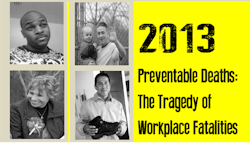Workers’ Memorial Day: Report Urges Safety Reforms to End Preventable Deaths
In a report detailing the personal stories of workers who lost their lives on the job in recent years, The National Council for Occupational Safety and Health (National COSH) pairs personal stories with government data to highlight the need for worker health and safety reforms.
The report, “Preventable Deaths: The Tragedy of Workplace Fatalities,” was released just days before Workers’ Memorial Day, which is held April 28 every year to commemorate the workers who were injured or killed on the job. According to the latest complete data available, more than 4,600 workers were killed on the job in 2011 – workers who spanned many ages, industries and causes of death.
“Each worker killed is a tragic loss to the community of family, friends and co-workers – and the worst part is, these deaths were largely preventable,” said Tom O’Connor, executive director of National COSH. “Simply by following proven safety practices and complying with OSHA standards, many of these more than 4,600 deaths could have been avoided. But as companies decry regulations and emphasize profits over safety, workers pay the ultimate price.”
The report especially pushes for reforms to better protect temporary workers, immigrant workers and energy workers.
For example, the death of 21-year-old Lawrence Daquan “Day” Davis on his first day on the job as a temporary worker at the Bacardi Bottling Co. in Jacksonville, Fla., highlights the need for adequate training and protection of temporary workers – who now comprise 25 percent of the workforce.
Immigrant workers also are vulnerable. These workers often work some of the most dangerous jobs in hazardous industries to try to build a better life in America, but a disproportionate number of them die on the job. More than two Latino workers were killed on the job every day in 2011, many of whom were immigrant workers.
The report also addresses issues including the health and safety of workers in the energy sector; workplace violence; the occupational hazards faced by young agricultural workers; inadequate fines for workplace safety violations; heat stress; whistleblower protection; and more.
Making Workplaces Safer
The report offered recommendations for what OSHA, Congress and states can do to strengthen workplace safety. The report’s suggestions include:
- Meaningful immigration reform, which would bring undocumented workers out of the shadows and give them protections afforded to all workers.
- A stronger Occupational Safety and Health Act, which would make felony charges possible when repeat or willful violations result in a worker's death or serious injury, and would increase the penalties OSHA can impose on negligent employers.
- An Injury and Illness Prevention Standard, which would require employers to find and fix health and safety hazards in the workplace.
- State legislation to protect temporary workers on the job, which can be modeled after Massachusetts’ new Temporary Workers Right to Know Law.
- State legislation to implement minimum penalty amounts for serious safety citations related to workplace fatalities, which can be modeled after Minnesota’s legislation that requires its state OSHA program to levy fines of no less than $25,000 for every serious violation and, in cases involving repeat or willful violations, no less than $50,000.
“With nearly 13 workers being killed on the job every day, it is essential to enact reforms to ensure that workers make it home safely at the end of every shift,” said Barbara Rahke, executive director of the Philadelphia Project on Occupational Safety and Health (PhilaPOSH) and a National COSH board member. “Together, we can point to regulatory and employer shortcomings and push for reforms to make workplaces safer – for all workers in all industries.”
About the Author

Laura Walter
Laura Walter was formerly senior editor of EHS Today. She is a subject matter expert in EHS compliance and government issues and has covered a variety of topics relating to occupational safety and health. Her writing has earned awards from the American Society of Business Publication Editors (ASBPE), the Trade Association Business Publications International (TABPI) and APEX Awards for Publication Excellence. Her debut novel, Body of Stars (Dutton) was published in 2021.
